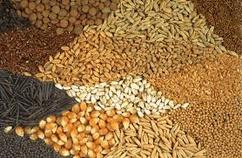
tomato seeds and a packet of basil. There were some packets of things that I killed off early and thus don't bear remembering. I don't recall the name of the variety of tomato, and it wasn't an heirloom variety as I now insist. I just grabbed it walking by a rack of them in a grocery store. What I didn't know, or even consider, was the different ways in which seeds work. How are they pollinated? From where did they come? Were they hybrids? Were they heirloom? What did that even mean? So many questions. In fact, there were questions I didn't even know I should be asking. To make it easy for new gardeners, or even for those green thumbs that just aren't sure what all the terms mean but do well through effort and skill, I'll outline the terminology and discuss it.
Seeds and open pollination
Open pollination is when a plant requires an outside force or action for its pollination. This includes, but is not limited to, insects (think bees), wind and animals. Think of your typical tomato plant. It requires a little help to ensure it germinates and grows. Open-pollinated plants are subject to mixing with other varieties of the same types of plant, which has both benefits and drawbacks, depending on what you're trying to accomplish. The mixing ensures and promotes biodiversity, which protects the planet's flora. The interbreeding can be a hassle to farmers that are trying to produce only one variety, and it often requires fields be separated by a considerable distance.
What does this mean to you? If you have a garden with open-pollinated plants, as you most likely will, you will want to consider placing them near where they'll be easily accessible by the mechanisms doing the pollination. An example of this would be locating your tomatoes near flowers and plants that naturally attract bees, such as blueberries or foxglove.
Seeds and controlled pollination
Controlled pollination refers to a few things, including self pollination and contained pollination. The first category includes plants, such as sunflowers, peanuts and beans, that are pollinated with no help from outside forces. This is called Cleistogamy. The second is when open-pollinated plants are enclosed to ensure that the plants don't mix with outside pollen, such as in a greenhouse. Contained pollination is used to ensure a plant breed doesn't cross with another variety of the same plant.
Hybrid seeds
A hybrid seed is a seed that had been bred from two varieties of the same plant. Gregor Mendel first discovered that peas mixed together from two varieties would pass on the traits of both parents to the next generation. Since then, we’ve been able to develop hybrid seeds. It wasn’t until the 1920s, when industry developed a maize hybrid that would consistently pass on the favourable traits of the parents, that we began to see hybrid seeds in common use. The second generation seeds of hybrids pass on random parent traits so the seed traits cannot be guaranteed and the seeds are generally not saved and used. The hybrid seeds that were commonly used in the 1920s had to be purchased year after year by the farmers that started using them. Hybrids today are very much the same. If you choose to garden with a hybrid, the seeds you choose to save will have unknown characteristics when the next generation grows. If this suits your needs, then hybrids are an option for you. I choose not to use them simply because I’d rather know what I’m getting when I save my seeds. There is nothing inherently unnatural or dangerous about using hybrid seeds, and they shouldn’t be confused with genetically modified organisms (GMOs) or genetically engineered (GE) seeds.
Heritage or heirloom seeds
These are seeds taken from plants that have never had pesticides applied and never been hybridized. For a seed to be an authentic heritage or heirloom seed, we have to be able to trace its roots back at least 50 years. Some are documented back to colonial gardens and beyond. This time predates the common or widespread use of commercial pesticides. The importance of heirloom varieties cannot be stressed enough. These varieties ensure that we won't continue to grow only a few varieties while excluding all others. Consider the case of apples. In the 1800s, there were thousands of apple varieties grown all across the world. If you look on your supermarket shelves today, you'll find no more than 6, if you're lucky. We must preserve a large variety of seeds to ensure that we maintain the biodiversity of our food. The Irish potato famines are clear examples of why this is crucial. Most Irish potatoes were of the same variety, and when a blight affecting that type swept through the country, the lack of variety caused tremendous upheaval as families across Ireland starved or suffered.
Seed circles
A seed circle is a group of people that save and trade the seeds produced by their plants. Seed circles can save flower or fruit seeds, but most commonly preserve open-pollinated vegetable seeds. The Victory Garden Society of BC operates/manages a seed circle in the Lower Mainland. Members of this, and any other, seed circle are able to consult a list of seeds that are available, get those seeds and plant them. Those members are then responsible for ensuring they save that type of seed for others to use the next year. In this way, members of the seed circle protect our biodiversity and also get free seeds. New gardeners or community gardens and school gardens are all welcome to join and have access to the seed circle stockpile. Simply contact [email protected] for information.
Submitted by Richard
 RSS Feed
RSS Feed
